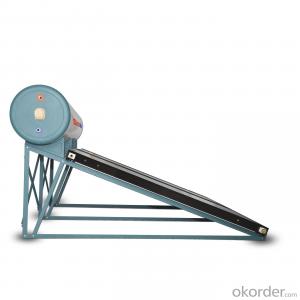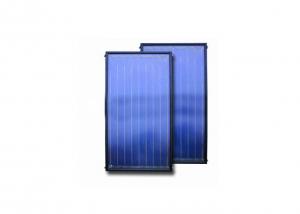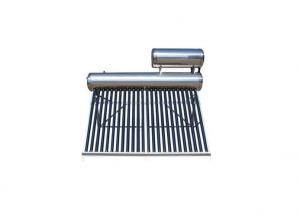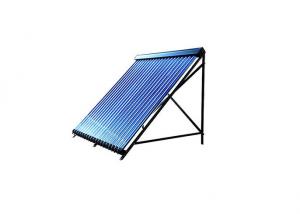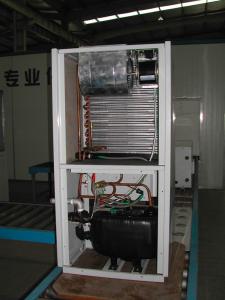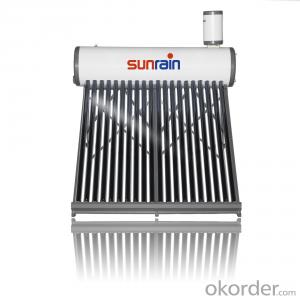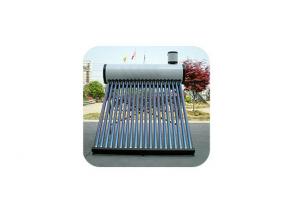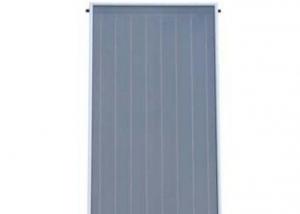Pressurized flat plate solar water heater
- Loading Port:
- China Main Port
- Payment Terms:
- TT OR LC
- Min Order Qty:
- -
- Supply Capability:
- -
OKorder Service Pledge
Quality Product, Order Online Tracking, Timely Delivery
OKorder Financial Service
Credit Rating, Credit Services, Credit Purchasing
You Might Also Like
| Type | Flat plate |
| Pressure | Pressurized |
| Circulation Type | Direct /Open Loop (Active) |
| Heating System | Thermosyphon (Passive) |
| Connection Type | Direct-Plug |
| Certification | CE |
| Model Number | PFPS1150, 1200,1300 |
| Recommend region | world wide |
- Q:Can a solar water heater be used in areas with high salinity water?
- Yes, a solar water heater can be used in areas with high salinity water. However, it is important to consider the potential effects of the high salinity on the system. High salinity can cause mineral build-up and corrosion, which may affect the efficiency and lifespan of the solar water heater. To mitigate these issues, it is recommended to use materials that are resistant to corrosion and to regularly maintain and clean the system.
- Q:What are the installation requirements for a solar water heater's temperature control system?
- The installation requirements for a solar water heater's temperature control system may vary depending on the specific model and manufacturer. However, there are some general guidelines and considerations to keep in mind when installing such a system. Firstly, it is important to ensure that the solar water heater itself is installed correctly and functioning properly. This includes positioning the solar collectors in a location that receives adequate sunlight, as well as connecting the necessary plumbing and electrical components. When it comes to the temperature control system, there are a few key requirements to consider. One of the primary components of this system is the temperature sensor, which is used to measure the temperature of the water in the storage tank. The sensor should be installed in a position where it can accurately measure the temperature without being affected by external factors, such as direct sunlight or drafts. In addition to the temperature sensor, the control system will typically include a controller or thermostat that regulates the operation of the solar water heater. This controller may have specific installation requirements, such as being mounted in a certain location or connected to the solar water heater in a particular way. It is important to carefully read and follow the manufacturer's instructions for installing the controller to ensure proper functionality. Furthermore, the temperature control system may require the installation of additional components, such as valves or pumps, to regulate the flow of water and maintain the desired temperature. These components should be installed according to the manufacturer's instructions and may require professional plumbing or electrical work. Overall, the installation requirements for a solar water heater's temperature control system will depend on the specific system being used. It is crucial to carefully review the manufacturer's instructions and guidelines to ensure a proper and safe installation. If in doubt, it is recommended to consult a professional installer or technician who is experienced in solar water heater systems.
- Q:What is the expected lifespan of the pump in a solar water heater system?
- The expected lifespan of a pump in a solar water heater system can vary, but typically ranges between 10 to 15 years. However, with proper maintenance and regular servicing, the pump can potentially last even longer.
- Q:What materials are used in the construction of a solar water heater?
- Solar water heaters are typically constructed using materials such as solar collectors, which are made of glass or metal, insulated storage tanks, piping systems, pumps, and control devices. These materials work together to harness the sun's heat and transfer it to water, enabling the efficient heating of water using renewable energy.
- Q:Solar water heater inside the scale how to clean it?
- Cleaning method of solar water heater scale, the water out of the tank, the hands hold the vacuum tube rotate back and forth, make its loose, then turn on the water tank to the bottom to push out from the base, and then pulled down, so that you can remove the vacuum tube, the vacuum tube in the water drained, and then use clean water repeatedly rinse clean, which in turn will be vacuum tube after cleaning the tank to add tap water, so that the scale in the water tank outflow, and then one by one the vacuum tube can be installed, the installation should check the sealing ring mounting hole of the water tank is intact, if damaged, should be replaced with a new sealing ring.
- Q:Can a solar water heater be used in areas with limited access to solar radiation data?
- Yes, a solar water heater can still be used in areas with limited access to solar radiation data. While solar radiation data can help optimize the efficiency of a solar water heater, it is not essential for its operation. Solar water heaters rely on sunlight to heat water, so as long as there is some level of sunlight available, the system can still function and provide heated water. It may be beneficial to gather local weather patterns and historical data to estimate the potential solar radiation in the area, but it is not a prerequisite for using a solar water heater.
- Q:What is the impact of water pressure on the performance of a solar water heater?
- The impact of water pressure on the performance of a solar water heater is significant. Higher water pressure allows for better flow rate, ensuring efficient transfer of heat from the solar collectors to the water. It also helps in maintaining a consistent and steady supply of hot water. On the other hand, low water pressure can hinder the heater's performance, resulting in slower heating times and reduced overall efficiency. Therefore, it is crucial to have adequate water pressure for optimal functioning of a solar water heater.
- Q:What is the impact of nearby buildings or structures on the performance of a solar water heater?
- The impact of nearby buildings or structures on the performance of a solar water heater can vary depending on several factors. Firstly, the position and orientation of nearby buildings can affect the amount of sunlight that reaches the solar water heater. If the buildings are tall and obstruct the path of sunlight, it can significantly reduce the amount of solar radiation reaching the solar panels, thus affecting the efficiency of the system. However, if the buildings are positioned in a way that allows for maximum exposure to sunlight, the performance of the solar water heater can be enhanced. Secondly, nearby buildings can create shading patterns that change throughout the day. This can cause fluctuations in the temperature of the solar panels, which may affect the overall performance of the system. If the shading is intermittent and minimal, the impact may be negligible. However, if the shading is constant and covers a significant portion of the solar panels, it can result in reduced heat absorption and lower water heating efficiency. Additionally, the presence of nearby structures can also impact the wind patterns around the solar water heater. If the buildings create wind tunnels or block the airflow, it can affect the cooling capacity of the system. Proper ventilation is crucial for efficient heat dissipation, so any obstruction to the airflow can potentially decrease the performance of the solar water heater. Moreover, the proximity of nearby buildings can affect the maintenance and cleaning process of the solar water heater. If the buildings are too close, it may be challenging to access and maintain the system, which can lead to a decrease in performance over time. In conclusion, nearby buildings or structures can have both positive and negative impacts on the performance of a solar water heater. It is important to consider factors such as sunlight exposure, shading patterns, wind patterns, and maintenance accessibility when installing the system to maximize its efficiency.
- Q:Can a solar water heater be used in areas with high levels of air pollution from natural sources (e.g., wildfires)?
- Yes, a solar water heater can still be used in areas with high levels of air pollution from natural sources such as wildfires. While air pollution may affect the overall efficiency of the solar thermal system, it does not render it completely useless. Solar water heaters utilize the sun's energy to heat water, primarily through the absorption of sunlight by solar panels or collectors. Even in areas with high levels of air pollution, there is still sunlight available, albeit potentially reduced due to the presence of smoke or particulate matter in the air. The level of efficiency of a solar water heater in such areas may vary depending on the severity and duration of air pollution events. During periods of intense wildfires, the sunlight reaching the solar panels may be reduced due to the smoke and haze in the atmosphere. This can lead to a decrease in the overall performance and heating capacity of the system. However, it is worth noting that solar water heaters have built-in mechanisms to adapt to varying weather conditions, including cloudy or smoky days. They are designed to capture and convert as much sunlight as possible, even under suboptimal circumstances. Additionally, advancements in solar technology have led to the development of more efficient solar panels that can better handle reduced sunlight. To maximize the effectiveness of a solar water heater in areas with high levels of air pollution, regular maintenance and cleaning of the solar panels may be required. This helps to ensure that any dust or soot particles accumulated on the panels are removed, allowing for better sunlight absorption. In conclusion, while air pollution from natural sources like wildfires may have some impact on the efficiency of a solar water heater, it can still be used in areas with high levels of pollution. The system may experience reduced performance during periods of intense air pollution, but it is still a viable and environmentally friendly option for heating water.
- Q:Can a solar water heater be used for both hot water and space heating?
- Yes, a solar water heater can be used for both hot water and space heating. It can be connected to a radiant heating system to provide warmth for the entire house, in addition to heating water for domestic use.
1. Manufacturer Overview |
|
|---|---|
| Location | |
| Year Established | |
| Annual Output Value | |
| Main Markets | |
| Company Certifications | |
2. Manufacturer Certificates |
|
|---|---|
| a) Certification Name | |
| Range | |
| Reference | |
| Validity Period | |
3. Manufacturer Capability |
|
|---|---|
| a)Trade Capacity | |
| Nearest Port | |
| Export Percentage | |
| No.of Employees in Trade Department | |
| Language Spoken: | |
| b)Factory Information | |
| Factory Size: | |
| No. of Production Lines | |
| Contract Manufacturing | |
| Product Price Range | |
Send your message to us
Pressurized flat plate solar water heater
- Loading Port:
- China Main Port
- Payment Terms:
- TT OR LC
- Min Order Qty:
- -
- Supply Capability:
- -
OKorder Service Pledge
Quality Product, Order Online Tracking, Timely Delivery
OKorder Financial Service
Credit Rating, Credit Services, Credit Purchasing
Similar products
New products
Hot products
Hot Searches
Related keywords
